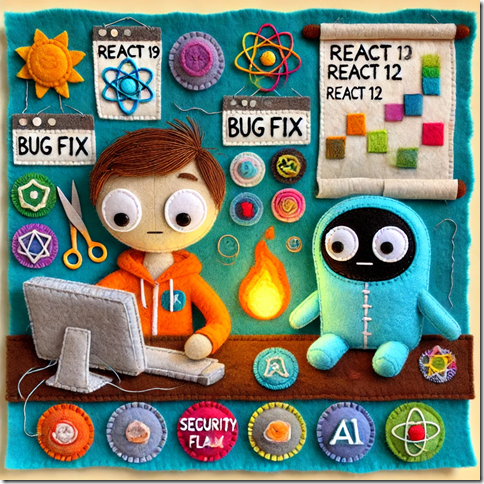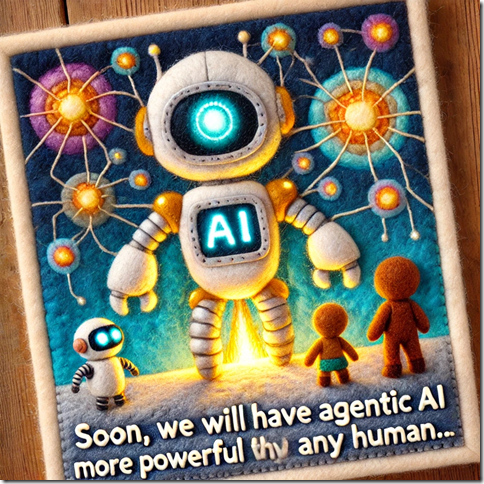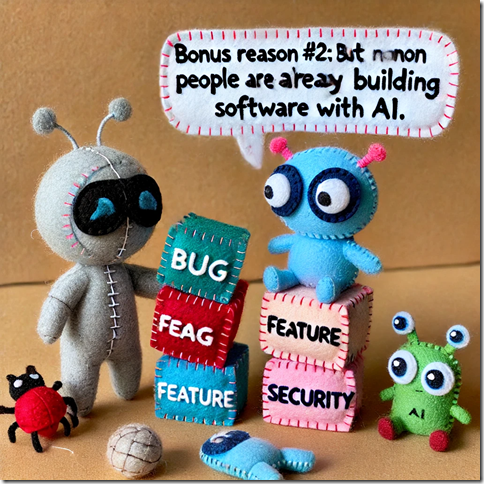Let’s talk about replacing software engineers and developers with AI, shall we?
And let’s examine this from a point of logic thinking.
1. OpenAI and Meta Claims to Replace Entire Careers with AI
By now you have heard that OpenAI predicts that all software developers will be replaced with AI soon. You have also heard that Meta plans to replace all mid-level software engineers this year.
Let’s think about that for a moment.
If Meta can replace all those roles that easily… Why can’t you?
In fact, there will be thousands of mid-level engineers with Meta experience on the market and with a few prompts, you can effectively replace Facebook.
Does that sound like a reasonable story? Of course it doesn’t.
It’s the same with OpenAI. If they truly believe they can create an Artificial General Intelligence that beats all but a few handfuls of developers… why are they still desperately trying to recruit developers?
Why can’t they just use their own AI? Heck, they claim to make PhD level AIs, but are still paying hundreds of thousands of dollars to hire more human PhDs?
Which is it Meta and OpenAI? Are you replacing humans and if so, what stops your competition from just using your own AI to replace you? There certainly won’t be any shortage of people that know your codebase and could recreate whatever you have done already, including the AI that replaced them.
The values of OpenAI and Meta would drop to zero overnight if what they are saying is true. If they actually believed what they are saying, why would they invest so much money and time into destroying their own company?
Note that I am picking on Meta and OpenAI because they are the most vocal and easiest targets. I know, I’m lazy.
However, even for smaller companies, the same logic applies; if your moat, your competitive advantage, the thing on which you build your business, is simply replicable by someone reverse engineering your business plan and feeding it to ChatGPT, how long do you think those businesses last?
2. Soon, we will have Agentic AI more powerful than any human. Just look at how fast we have gotten here!
I want to show you something.
https://www.youtube.com/watch?v=1FXZ8ZY_H44&t=1s
This is a video we made at MOBGames. It is an AI that creates scripts inside the game engine Unity. It’s not just a chatbot it actually has agency to create and call those scripts inside the game engine.
Then, because it makes a mistake, it not only detects that mistake but also fixes it.
Sounds like sci-fi right? And yet, you see it with your own eyes, in a non-edited video. I can assure you this is real.
This is what everyone is promising will come out soon – agents that are agentic, meaning that they can take actions on their own to achieve a goal rather than just responding to a prompt.
But do you want to know what’s the big secret?
This is made with OpenAI GPT3.5. It was made several years ago.
That is what LLMs were already able to do in 2022. So if that was possible so long ago, where’s that massive surge in power and quality?
The simple answer is that it doesn’t exist. The last major breakthrough was the release of GPT4. That is the gold standard today, albeit with some minor version magic in 4o.
Even the GPT4 models weren’t that big a leap. Many suspected that GPT4 might actually just be several 3.5 models that were trained and tuned on different datasets.
The jump from 3.5 to 4 was maybe a 20-30% increase in quality.
And nothing has happened since then. We went from zero to GPT3.5 to 4.0 in a matter of months and then…
Nothing.
Note: The reality is that we didn’t go from zero to 3.5, we went from theoretical models over a century ago, through hundreds, literally, years of thinking, planning, solving, and designing. We went through GANs and RNNs and only in 2017 (that’s almost a decade ago) did we get transformers and self-attention.
Despite billions being invested in AI and training, there’s no GPT-5 now or any time soon.
Even if it came out tomorrow, it wouldn’t be the breakthrough that is needed to get us to a level where the quality of a human software engineer can be replaced.
And even if that happened, see my previous point about what it would take to just replicate OpenAI or Facebook if it is true that you can just fire the majority of your developers and use an AI or two instead.
But let’s assume you could, by magick, manifest GPT-5 tomorrow and that it would be as good as everyone hopes, and that it can replace every single software developer.
You still have to contend with the knowledge cut-off dates.
3. What about knowledge cut-off dates?
Language models like GPT-4 or the possible GPT-5 require insane amounts of computing power to train. How much? Nvidia currently is the second or third most valuable company in the US, that is how much.
So far, it has taken over two years to get from GPT4 to something better (not counting the intermediate 4o versions) and we still don’t have any news from Sam Altmann, who seems to want to tweet or hold an interview every time someone goes to the bathroom at OpenAI.
Here’s why that will prevent software engineers from being replaced by AI.
When a new model gets its training data, you fix a point in time, after which the model will not know anything.
This is a major issue for the quality of a GPT-type model and especially for one aimed at building software.
Because, you see, software changes at an astounding rate. A model like GPT4 is not able to keep up and does not know anything about newer versions of frameworks like .NET 9, React 19, or Django 5.1.
It must be retrained on completely new training data, which can take months or years, and cost billions of dollars in compute power.
Let’s take that one step further.
Let’s say React 20 comes out the day after GPT-5 comes out.
A human can start experimenting and checking out new features of React 20 in about 15 minutes. Then, the human will gain experience. Maybe it will write a blog post or push some PRs to Github for an issue they discovered.
GPT-5 cannot. You might say that because GPT-5 can browse the web, it can also look up new and current information, but especially for software, documentation, examples, and code history can be hundreds if not thousands of pages. Including that for every prompt exchange just so you can ask how to make a button in React 20 would take far more resources than a human and be much, much slower.
Only at the point where humans have that experience, after those issues have been resolved, after those blogs with instructions, after those patterns of upgrade has been invented… Only then can an LLM be trained on that data.
And it will costs billions. Or it will be too old and unable to be productive by the time it can be released.
This is the case for every model out there. To get to a human level understanding of new versions of software, much less have access to any information about how to upgrade an old version to a new, you need to retrain the models, and you need to spend those billions of dollars or your model will be out of date.
4. Bonus reason: What about o1 and o3?
You’ll notice that above, I have avoided mentioning OpenAI’s o1 and o3 models.
The main reason is that these are not models, per se, but more like workflows that uses existing models. Even if it technically might be a new model, it certainly isn’t isolated more capable than the latest 4o models, and it certainly is limited by the same limitations of cut-off date. It also hasn’t really shown any major progress in quality.
o3 might be very smart, but it isn’t smart because it has a better training set, it is better because it uses a more complex workflow. It ‘reasons’ and uses ‘chain of thought’ to verify it’s answers.
It still won’t know anything about a single software release after its cut-off date.
5. Bonus reason #2: But non-tech people are already building software with AI
Yes they are. And non-tech people have been building software for decades. Lotus Notes, Microsoft Access, SharePoint… An endless series of platforms and software claims to finally, this time, no no, this time, non-developers are finally to be able to do what developers are doing.
Would it surprise you that few, if any, of those solutions survive more than a short time? That a huge amount of security issues and stability problems arise from people who can barely spell those ideas and are unable to describe their solutions to a machine?
Here’s a simple test: Have a current LLM build a solution using only libraries and frameworks that were available 12 months ago. Then, use the same or any other LLM to upgrade that solution to the current version of those libraries and frameworks.
Because if you don’t, you are subjecting yourself to all those security flaws and stability issues and lack of features that those old versions had, and what the current ones have.
So yes, non-tech people are generating code. They are not developing software. Developing software has barely been about writing software since the 80s and 90s.
Today, we programmers spend 95% of our time doing all the other stuff and not a single person has even written or speculated about how an LLM, agentic or otherwise, are going to solve those issues.
Thank you to Georg Zoeller for reading through this and fact checking and thus, I imagine, officially approving everything I say, past, present, or future, as absolute truth and in no way exaggerated or wrong.






Leave a Reply